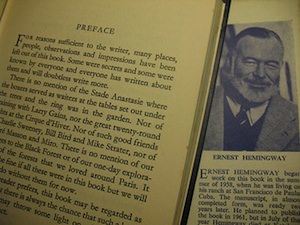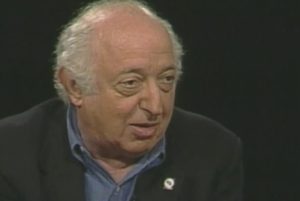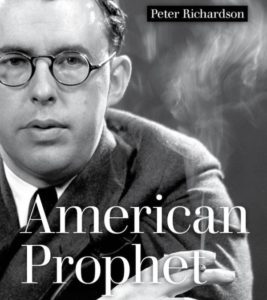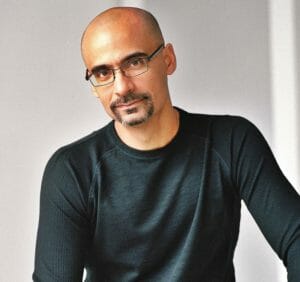Happy Birthday, Hemingway!
Sunday would be Ernest Hemingway's 114th birthday. More than anyone, he cleaned out the stuffy British conventions that clogged American writing in the 1920s and allowed the next generation to find their own voices.More than anyone, Ernest Hemingway cleaned out the stuffy British conventions that clogged American writing in the 1920s and allowed the next generation to find their own voices.
Pauline Kael, reviewing the film “Islands in the Stream” (1977), wrote, “There may be a time for a Hemingway revival, but this isn’t it. His themes don’t link with our preoccupations, and … the movie version of his posthumous novel, seems to belong to another age.”
Thirty-six years later, as we approach what would be Hemingway’s 114th birthday Sunday, his image is more vibrant now than in the last years of his life. The same could be said for his friend and drinking partner, F. Scott Fitzgerald.
This year belongs to Fitzgerald, with Baz Luhrmann’s glittery and successful film version of “The Great Gatsby” catapulting the novel onto best-seller lists.
The previous couple of years, however, were an unofficial Hemingway celebration, with books about him continuing to be a light industry. “The Letters of Ernest Hemingway, 1907-1922” was published by Cambridge University Press; soon we will have a complete set of volumes containing his entire correspondence. (Hemingway would never have seen the point in this. As he told a biographer of Fitzgerald’s, “I write letters because it is fun to get letters back, not for posterity. What the hell is posterity anyway?”)
“Hemingway’s Laboratory — The Paris in Our Time” by Milton Cohen, a study of the writer’s early prose experiments, was published in May 2012 by the University of Alabama Press. That summer marked the paperback release of Paul Hendrickson’s critically acclaimed “Hemingway’s Boat: Everything He Loved in Life and Lost.”
And, who’d have thought it, Hemingway in the 21st century has re-emerged as a pop (Papa?) icon. Just about everything Hemingway wrote, from his novels to eight collections of short stories to several memoirs and works of journalism, is still in print. That’s more than 25 volumes. Can that be said about any other serious American author?
Character actor Corey Stoll did a terrific turn as the mid-1920s Hemingway in Woody Allen’s “Midnight in Paris” in 2011, with English actor Tom Hiddelston contributing a letter-perfect Scott Fitzgerald. Allen, who won an Oscar for the screenplay, did his homework. Every line out of Stoll’s mouth sounds like the distilled Hemingway of our collective memory:
“It was a good book because it was an honest book, and that’s what war does to men. And there’s nothing fine and noble about dying in the mud unless you die gracefully. And then it’s not only noble but brave,” he says.
And, “No subject is terrible if the story is true, if the prose is clean and honest, and if it affirms courage and grace under pressure.”
Last summer, HBO’s “Hemingway & Gellhorn,” directed by Philip Kaufman, received 15 Emmy nominations. The most in-depth film portrait of the writer featured ferocious performances by Clive Owen as Hemingway and Nicole Kidman as his third wife, the great war correspondent Martha Gellhorn.
All the books about Hemingway have told us everything except why we continue to care so much.
With the exception of his first novel, “The Sun Also Rises,” which still reads with the freshness of an open wound, I can no longer read the big books on which Hemingway’s reputation has so long rested. “A Farewell to Arms” and “For Whom the Bell Tolls” seem stilted, stagey and Hollywood-cornball melodramatic. (I applauded the scene in “Silver Linings Playbook” when Bradley Cooper throws a copy of “A Farewell to Arms” out the window because “She dies. I mean, the world’s hard enough as it is, guys. Can’t someone say, hey let’s be positive? Let’s have a good ending to the story?”)
Like most people I know, I find all of Hemingway’s later novels unreadable. And not just the later works. “To Have and Have Not,” published in 1937, didn’t survive a rereading. According to film director Howard Hawks, Hemingway confessed that he wrote it only “because I needed the money.” Hawks supposedly told Hemingway, “I can take the worst piece of crap you ever wrote and make a good movie out of it.” Hemingway’s worst piece of crap, Hawks decided, was “To Have and Have Not.”
I agree. The novel is dishonest hackwork; Hawks’ film with Bogart and Bacall was first-rate hackwork.
How it must have galled Hemingway over the last 17 years of his life that when the title “To Have and Have Not” was mentioned, it was not his words people remembered but those written for Lauren Bacall by Jules Furthman and, of all people, William Faulkner — particularly “Anyone got a match?” and “You know how to whistle don’t you? You put your lips together and blow.” (Hemingway might have taken some solace in 1948 when John Huston pilfered the ending of “To Have and Have Not” for “Key Largo.”)
The reputation of “The Old Man and the Sea” (1952) hasn’t fared much better than the marlin the old man drags back to shore. Dwight Macdonald scored easy points when he said it was “written in that fake, biblical prose which Pearl Buck used in ‘The Good Earth,’ a style which seems to have a maligned fascination for the middlebrows — Miss Buck also got a Nobel Prize out of it.” Macdonald knew very well that at his worst, Hemingway was in a higher class than Buck and that “The Old Man and the Sea” isn’t Hemingway at his worst.
“Across the River and Into the Trees” (1950) and “Islands in the Stream” (published posthumously in 1970) are worthy of comparison with Buck, and I’m not sure Hemingway comes out ahead. His later fiction is pretty much summed up by a remark he made about John O’Hara, recorded in A.E. Hotchner’s “Papa Hemingway” (1955). When Hemingway first read O’Hara, “It looked like he could hit. … Then, instead of swinging away, for no reason he started beating out bunts.” Nevertheless, to judge from the evidence of “By-line: Selected Articles and Dispatches of Four Decades,” he was a superb journalist and war correspondent. Filing from Spain in 1937: “This is a strange new kind of war where you learn just as much as you are able to believe.”
And then he made us believe it. Writing fiction he had a weakness for the sentimental, but his journalism transmuted the terrible into something the reader could trust: “They wrote in the old days that is it sweet and fitting to die for one’s country. But in modern war there is nothing sweet nor fitting in your dying. You will die like a dog. …”
I don’t know, though, that he was as good a war correspondent as A.J. Liebling, who was much better at conveying war to the average man, possibly because he was an average man, or at any rate more average than Hemingway. Hemingway was not as good a war correspondent as Martha Gellhorn, with whom he openly competed. Hemingway the reporter took in much at first glance, but what he missed in his first glance he was likely to miss all together. Gellhorn had a more sweeping vision and was far more capable of objectivity — or at least of getting at the big picture without letting ego intrude. She never injected herself into a scene, as Hemingway did at D-Day when he wrote of an admiral who asked him, “Mr. Hemingway, will you please see what flag is over there with your glasses?” Fiction, surely; admirals don’t need celebrity novelists to assist them during battle.
There is much more great nonfiction to consider. “A Moveable Feast,” compiled and edited after Hemingway’s death, will always be a book that inspires young writers to move to Paris, and “Death in the Afternoon” is still mistakenly referred to as sports writing, despite Hemingway’s insistence that “Bull fighting is not a sport. It is a tragedy.”
It isn’t necessary to overcome one’s repugnance for bullfighting to be fascinated by “Death in the Afternoon,” if only because it’s the most incisive look inside a culture that was starting to fade well before Franco’s death. “For one person,” he wrote, “who likes Spain, there are a dozen who prefer books on her.” But for anyone who is interested in pre-Civil War Spain and what bullfighting reveals about its temper, “Death in the Afternoon” may be the only book there is for English speaking readers. One wonders what Papa would think about a Spain that cheers louder for soccer, basketball and tennis than for blood sport.
Finally, there are the stories. Even his severest critics admit that many of the stories have a value lacking in the novels. Nabokov, who was no fan, thought so. “I read him for the first time in the early ’40s,” he famously said, “something about bells, balls and bulls… .” Hemingway and Joseph Conrad were “writers of books for boys.” Ouch. But in 1963 Nabokov told an interviewer for Playboy that Hemingway was better than Conrad: “ … He has at least a voice of his own and is responsible for that delightful, highly artistic short story ‘The Killers.’ ”
If he had been in a more generous mood, Nabokov might have bestowed the same status to “A Way You’ll Never Be,” “A Clean Well-Lighted Place,” “Old Man at the Bridge,” “The End of Something,” “Soldier’s Home,” “The Undefeated,” “In Another Country,” “The Snows of Kilimanjaro,” “The Short Happy Life of Francis Macomber,” “Hills Like White Elephants” and a score of others. Nabokov also thought “the description of the iridescent fish and rhythmic urination in his famous fish story” — that would be “The Old Man and the Sea” — “is superb.” Go fish, Dwight Macdonald.
Even at his best, Hemingway teetered toward self-parody; no other American writer has been so easy to satirize. Even Raymond Chandler — the second-most parodied writer? — had a bead on Hemingway: “Hank unscrewed the top of the toothpaste tube, thinking of the day he had unscrewed the lid of the coffee jar, down on the Pukayuk River, when he was trout fishing. There are larches there, too. It was a damn good river, and the trout had been damn good trout. They liked being hooked. Everything had been good except the coffee, which had been lousy. He had made it Watson’s way, boiling it for two hours and a half in his knapsack. It had tasted like hell. It had tasted like the socks of the Forgotten Man.”
Hemingway’s reaction to Chandler’s jab is not known, but on reading “Across the Street and Into the Grill” by E. B. White in The New Yorker, he grunted, “The parody is the last refuge of the frustrated writer. … The greater the work of literature, the easier the work to parody.”
Maybe, but you make it easy if you have a lot of stylistic tics. When I was in college, “Fifty Works of English Literature We Could Do Without” by Brigid Brophy, Michael Levey and Charles Osborne (first published in 1968), was fashionable among glib young critics who wanted to dismiss books and authors they didn’t quite know how to deal with. Here are some passages I quoted in a paper when I was a smug student at the University of Alabama:
“In place of Gertrude Stein’s varied, and purposely varied, cadences, Hemingway ties one short, blunt instrument to another by means of and: ‘She had a lovely face and body and lovely smooth skin too. We would be lying together and I would touch her cheeks and her forehead and under her eyes and chin and throat with the tips of my fingers. …”
Brophy, or whoever wrote the book’s Hemingway chapter, didn’t like the “ands” or the repetition of “lovely” that in several ways had violated Gertrude Stein’s principles. I’m going to have to take that on faith as I’ve never read Stein and I’m not going to read her now just to determine where Hemingway went wrong. Hemingway’s admirers praise him for economy of language; Brophy lashes him for “splashing over his pages the half-literate vocabulary of a Victorian provincial sporting journalist.” (But did she really read Victorian provincial sporting journalists?) Faulkner also made fun of the terseness of Hemingway’s prose when he jibed: “Hemingway never sent a reader scurrying to a dictionary.”
But I couldn’t care less about Stein’s dictums, and I don’t necessarily need a dictionary to enjoy fiction. Nor do I think one must be a sucker for bells, balls and bulls to appreciate Hemingway. More than anyone, he cleaned out the stuffy conventions and pretentions of British English that still clogged American writing in the early 1920s. His importance was not, as is often said, in influencing the prose style of the next generation but in clearing the path so they could better find their own voices. John Steinbeck, J.D. Salinger, John O’Hara, James Jones and Nelson Algren, to name some of the most obvious, would have happened without Hemingway, but they probably would not have been so good. Norman Mailer, who never truly succeeded at finding his own voice in fiction, was nonetheless inspired by Papa’s ethos to become the greatest American writer of the next generation.
No matter what Hemingway’s influence on future generations, we will never again be subject to what Hotchner called “an affliction common to my generation: Hemingway awe.” There will still be untold college papers and literary essays that try to resolve such questions as why the most archetypically American novelist never set a novel in his own country, or whether it was that manly All-American hunting and fishing or the piano lessons from his hated mother that most contributed to his development. Or why a most quintessentially macho figure in American letters had so many close female friends, from the lesbian Gertrude Stein, whose literary opinion he valued above all others, to his pal (but never lover) Marlene Dietrich, who said of him, “He is gentle, as all real men are gentle.”
Or perhaps the most intriguing question of all: Who was the greater writer, Hemingway or Fitzgerald? My answer is Hemingway. He had a steel-trap efficiency as an author and a greater range in his short fiction and nonfiction. But Fitzgerald came nearer to greatness as a novelist. His work deepened as he got older. Hemingway ended his career as he had begun, as an inspired adolescent. He burned with a hard gem-like flame for perhaps 10 years, and what he wrote beyond that span relied on the momentum of his extravagant influence.
We will always need them both, though, as the twin beacons of romance (Fitzgerald) and adventure (Hemingway) of the Jazz Age, the Lost Generation or whatever we choose to call it.
Philip Kaufman found himself drawing closer to Hemingway while filming “Hemingway & Gellhorn.” “My reservations about him — the macho posturing, the bullying, the tendency late in life toward self-parody — all fell away,” he told me. “What I most felt was the energy and the possibilities of life he made me feel when I was young.
“He offered the conversation of his time, and, who knows, maybe for times to come.”
And if it’s not that, what the hell is posterity anyway?
Your support matters…Independent journalism is under threat and overshadowed by heavily funded mainstream media.
You can help level the playing field. Become a member.
Your tax-deductible contribution keeps us digging beneath the headlines to give you thought-provoking, investigative reporting and analysis that unearths what's really happening- without compromise.
Give today to support our courageous, independent journalists.





You need to be a supporter to comment.
There are currently no responses to this article.
Be the first to respond.